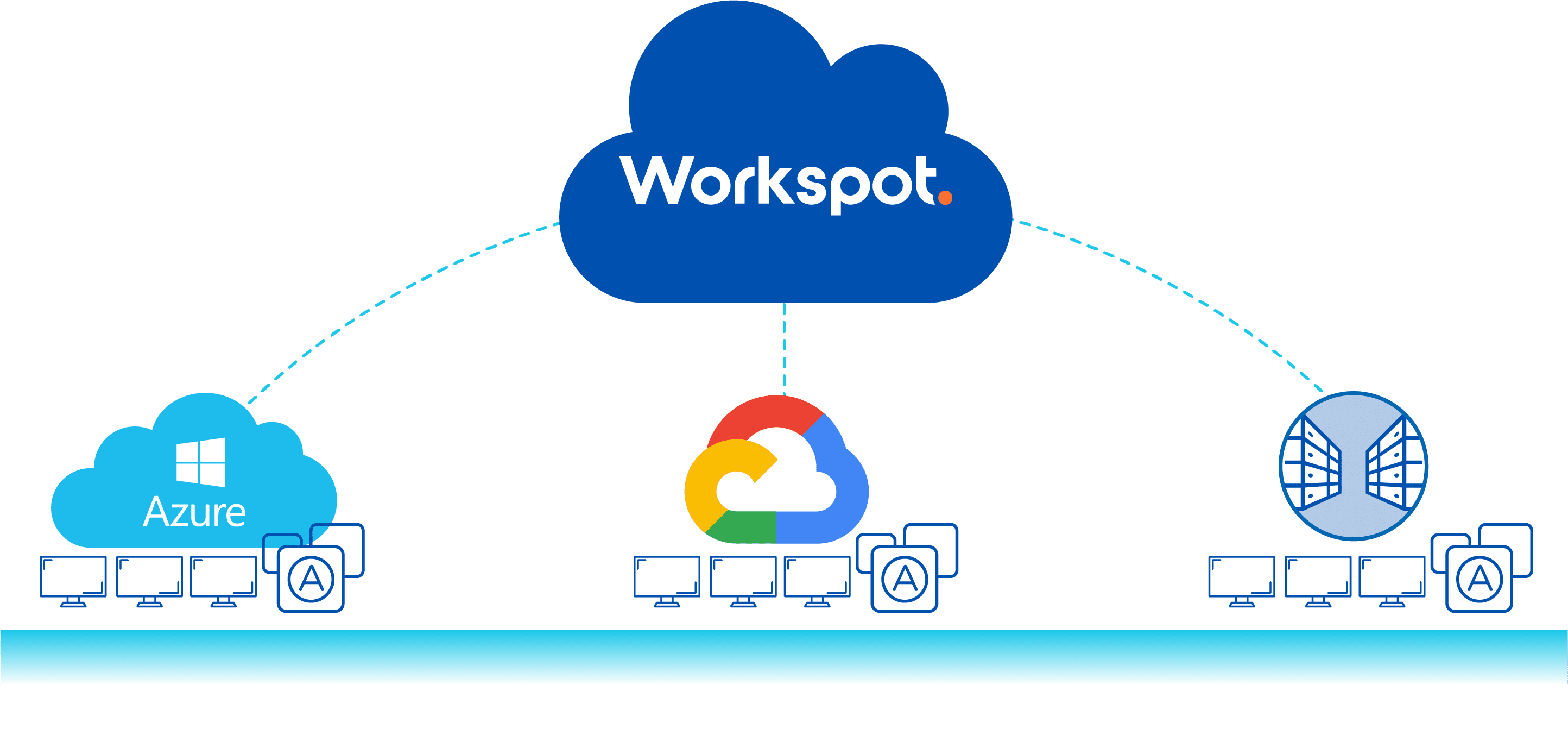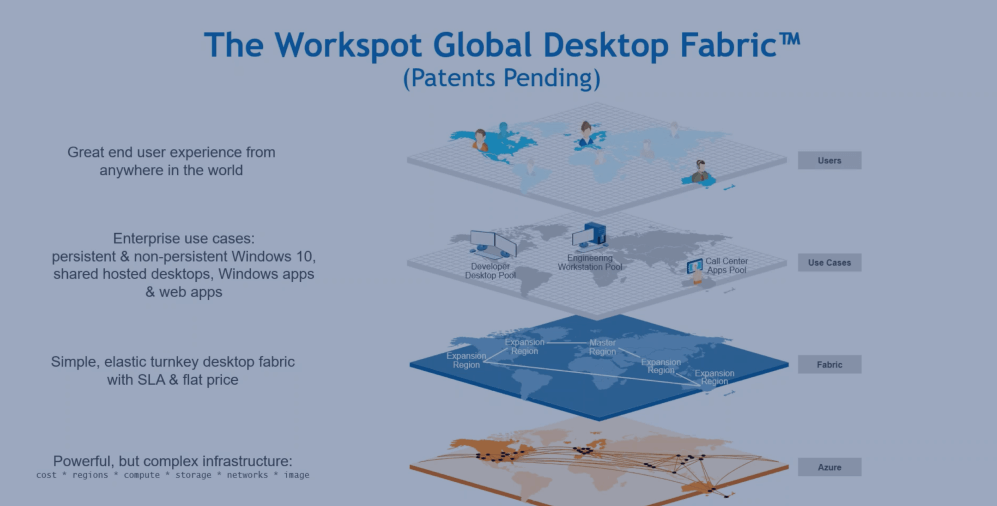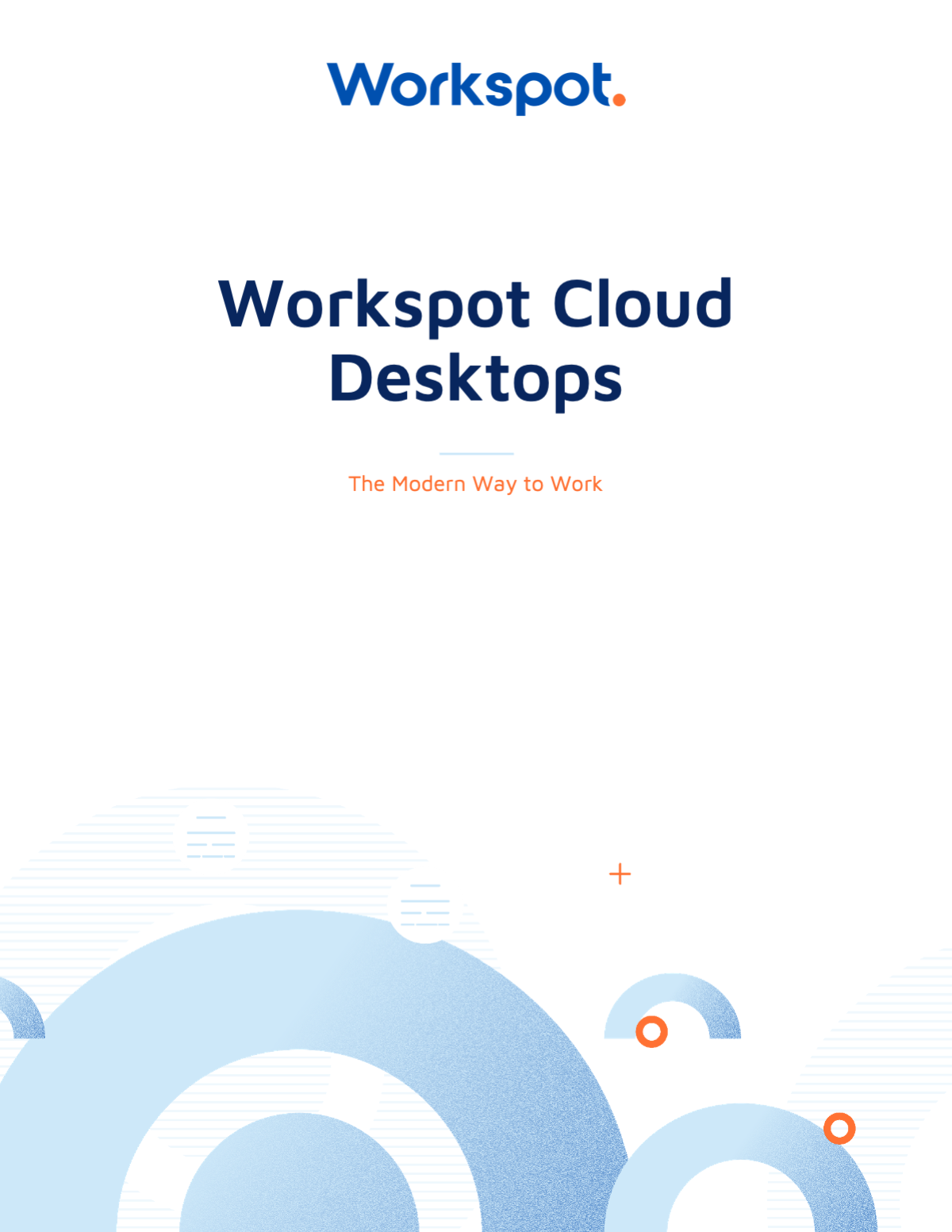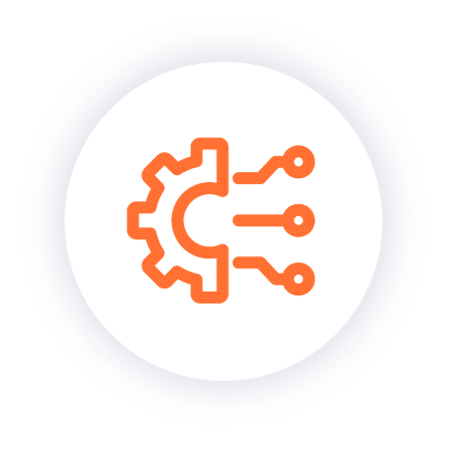What is a Cloud PC?
A Workspot Cloud PC is just like a Windows 10/11 PC, but it’s delivered from the public cloud as software-as-a-service (SaaS) and end users can access all their apps and data from anywhere, using their device of choice. Workspot completely reinvented virtual desktops with its 100% cloud-native SaaS platform – the Workspot Enterprise Desktop Cloud™ – which is global, highly secure, and enterprise-proven. Combined with the global ubiquity of Microsoft Azure, Google Cloud, and Amazon Web Services, Workspot enables IT teams to deploy hundreds or thousands of Windows 10/11 cloud desktops across multiple cloud regions, anywhere on the planet – fast.
Workspot Cloud PCs supercharge your business agility and competitiveness while eliminating the upfront CapEx of traditional VDI and the cumbersome hardware refreshes required for physical PCs. With SaaS Cloud PCs, global enterprise IT teams no longer need to procure, set up and ship physical devices to end users, freeing them from expensive and time-consuming “keep the lights on” tasks so they can focus on more strategic projects that drive business growth.
Purpose-Built for the Global Public Cloud
Combining the Workspot Enterprise Desktop Cloud platform with the global power of Microsoft Azure, Google Cloud and Amazon Web Services is transforming enterprise organizations around the world empowering workers with desktop virtualization, virtually anywhere! Workspot is the only SaaS Cloud PC solution that is completely customizable to meet the unique needs of enterprise organizations, while strengthening application security and bringing new levels of agility that drives business growth.

Deploy Workspot Cloud PCs across Microsoft Azure, Google Cloud, AWS and on-premises infrastructure to meet your unique requirements.
Cloud PC Capabilities

Use Cases for Cloud PCs
Augment Zero-Trust Security policy
Trust no one – not even your virtual desktop provider! When it comes to security, ask the tough questions to ensure the principle of least privilege (POLP) is rigorously enforced. Additionally, it’s fundamental to understand the security implications of the solution architecture, and why choosing a 100% cloud-native architecture is essential for security.
Enable remote employees, contractors and partners
Enterprises rely on remote employees, offshore contractors and partners for a variety of projects. Securing intellectual property and maintaining high productivity while working remotely is a challenge for enterprises employing a global workforce. Here’s how Workspot cloud PCs and workstations support secure remote work.
High-performance computing
Latency kills performance, and that’s why power users have never been satisfied with virtual desktops – until now. Placing cloud PCs and workstations in the cloud region closest to each user changes everything, typically mitigating latency to imperceptible levels. Outstanding cloud PC performance keeps even the most demanding power users happy and productive, wherever they are working.
Set up call centers anywhere globally
Organizations can deploy call centers anywhere in the world and ensure secure access to data by call center employees. With Workspot, call center employees can be situated anywhere – including shared office space and home offices.
Streamline joint venture operations to improve profitability
AEC, financial services and life sciences are just a few of the industries where partnership and joint ventures are central to innovation. Cloud PCs enable project teams to easily work together, collaborating in real time to bring products to market more quickly and with higher quality. IT processes are dramatically simplified, since everyone uses the same technology and collaborates within a common data environment.
Is there a difference between a Cloud PC and a Cloud Desktop?
Workspot coined the term “Cloud PC” in 2019. Generally, “cloud PC” and “cloud desktop” are used interchangeably. Some people believe the term “Cloud PC” is inclusive of both “cloud desktops” and GPU-accelerated “cloud workstations” and they use “cloud PC” as an umbrella term that encompasses both cloud desktops and cloud workstations. At Workspot we try to be specific about whether we are talking about a cloud desktop or a cloud workstation, and for brevity we often use the term “cloud PC” as well.
Why should I consider cloud desktops?
The public cloud has created an opportunity for enterprises to deliver cloud desktops and virtual applications at a scale previously unachievable with existing technologies, such as legacy VDI. When desktops are centralized in a public cloud, enterprises gain agility, as they can quickly spin up desktop resources when and where they are needed. They gain built-in business continuity and disaster recovery because employees can access their desktops from any device and from any location. IT organizations can also reduce desktop TCO through simplified IT processes and the use of lower-cost endpoints.
For another perspective about cloud desktops, read the report from analyst ESG: Top 10 Accelerants for Cloud-Hosted Desktops in 2020.
Is the Workspot SaaS Cloud PC solution different than Windows 365?
Organizations have many choices as they evaluate virtual desktops and solutions vary widely in their capabilities. A thorough evaluation begins with examining the solution architecture, as the design dictates what you can and cannot achieve.
The Workspot Enterprise Desktop Cloud and Windows 365 platforms are both SaaS solutions. IT teams would select one over the other based on these key considerations:
- Flexibility: How much flexibility do you need? Multi-cloud? Support existing security and management tools?
- Performance: Do you have power users who can’t compromise on performance?
- TCO: Do you have multiple use cases? Would flexible pricing models per use case help you save money?
- 24×7 Monitoring: Data collected, analyzed and correlated across clouds generates actionable intelligence that helps keep your cloud PCs healthy. Is this provided?
Is the Workspot solution different from AVD??
The Workspot Enterprise Desktop Cloud and Microsoft Azure Virtual Desktops are fundamentally different approaches to virtual desktops. Workspot is an enterprise-proven software-as-a-service (SaaS) platform for delivering cloud PCs, where Workspot takes responsibility for the SLA of your cloud PCs.
Azure Virtual Desktop is a “do-it-yourself” approach to cloud PCs. Microsoft provides the virtual desktop broker, but the customer is responsible for the cloud PC SLA. This means they must have the right skills sets in-house to support the Azure and virtual desktop infrastructure, or they need to contract consultants/integrators to keep everything up and running.
What if my users are in multiple locations?
If you need to support users in multiple locations, whether around the country or around the world, here’s what you need to ask vendors about cloud desktops:
Where is the gateway located?
Some VDI solutions support a limited number of gateways, so if users are located in California, but the gateway is in NY, then substantial latency will be added, potentially impacting performance.
Are you able to place the cloud desktop in the public cloud region closest to the user?
The greater the distance between the desktop and the user, the higher the latency, and this can result in poor performance.
Most enterprises require multi-region cloud desktops, because the have employees and contractors all over the world. Learn more about the how Workspot’s solution architecture makes this possible.
What kind of IT resources do I need to have in-house?
Many cloud desktop solutions are really a collection of services and infrastructure. You’ll need to have in-house expertise in both VDI as well as in your public cloud of choice to build, maintain and troubleshoot infrastructure, provision cloud desktops, implement upgrades and ensure the overall cloud desktop SLA. If you don’t have these skill sets available, then you may want to consider a Managed Service Provider (MSP), or evaluate a SaaS cloud desktop service such as the Workspot Enterprise Desktop Cloud, Amazon Workspaces or Windows 365.
Here’s what a turnkey cloud desktop service means to our customers.
Which use cases is the system best suited to support?
There is a range of options, and we will help map your organization’s requirements to make sure all your users have the compute power they need.
- Persistent desktops:
Personalization for the cloud desktop is equivalent to a physical PC. A user starts with the company image, but is able to add customizations that are retained each time they log in. - Non-persistent desktops:
These are typically provisioned as a shared pool of desktops that do not retain customization. Users get a fresh desktop each time they log in. - Shared server/Windows 10 multi-user desktops:
For employees such as call center workers who need access to a basic Windows 10 desktop or application and typically do not run taxing workloads, shared server configurations can be a cost-effective option to consider. - GPU cloud workstations:
High-performance desktops with a graphical processing unit (GPU) are available in the public cloud, which can meet the needs of engineers, CAD designers, BIM managers, and other users with heavy processing requirements.
For examples of use case scenarios, see how our customers are putting cloud desktops to work.
What security and compliance requirements do I need to consider?
There are critical questions to ask cloud desktop vendors about security:
- Would shared, multi-tenant gateways cause any concern for the security team?
Some cloud desktop vendors are multi-tenant, but direct traffic through shared gateways, which can introduce risk. - Does the system separate the control plane from the data plane?
If the platform does not, it’s possible the cloud vendor can access your data, which compromises Zero Trust security policies. - Where is Active Directory running?
Will you need to move AD to the cloud, and if so, is this a problem for your security team? Some cloud services are based on Windows servers, and they may require that you install a domain controller in the cloud. This can put authentication credentials out of your control, and they pass through a system that isn’t yours. - Can I use my existing security, identity management, and multi-factor authentication solutions?
Some cloud PC vendors cannot support your existing technology for these capabilities. In particular, large enterprises need a cloud PC solution that provides the flexibility to use existing tools and processes.
To learn more about cloud desktop security considerations, read our blog.
Who owns the desktop SLA? What is my IT team responsible for?
Most solutions require your IT team to be responsible for desktop uptime and availability. Are you staffed to meet those needs?
Workspot takes ownership of the cloud desktop Service Level Agreement (SLA), allowing your IT team to work on more strategic projects. This means that we take care of overall Workspot platform maintenance and upgrades. Additionally, our deep instrumentation at all layers of the platform feeds our big data engine, which can identify problems in real-time and alert the IT or security teams, even when the issue is outside the Workspot system. This allows us to go well beyond just the cloud desktop SLA and assist with your overall Business SLA.
Read more about Workspot’s contribution to your “Business SLA” here.
What is the total cost of ownership (TCO) of the solution?
Here are some things to consider about cloud desktop costs: How will you track and manage solution costs? Do you need to manage each element separately?
For most cloud desktop solutions, you’ll need to monitor and manage several elements separately. For example, there are cloud compute costs (which differ by region), the cost of IT staff required to manage the system, the actual solution costs (licenses, support, infrastructure, etc…), and other elements. If your organization is resource-constrained, a turnkey cloud desktop service may be a better fit and can reduce overall desktop TCO.
Predictability: Is budget predictability important?
There are many stories about cloud desktop billing surprises— and not the pleasant kind. If this is a concern, or if parsing complex billing is too time-consuming for your team, consider a solution with flat-rate pricing that includes the cost of cloud compute.
What should our end users expect about cloud desktop performance?
It’s well-known that traditional VDI has a poor reputation when it comes to the end-user experience. The right cloud desktop solution can easily improve end-user satisfaction when compared to legacy VDI. So, the real comparison is between physical PCs and workstations and cloud desktops. This is the new “gold standard” of virtual desktop performance. By placing cloud desktops in the region closest to each user, performance is often better than a PC!
Here’s what you need to know about The New Math of VDI Performance.
Additional Resources
We’re here to help! Access these valuable resources to help guide your journey to cloud desktops.




